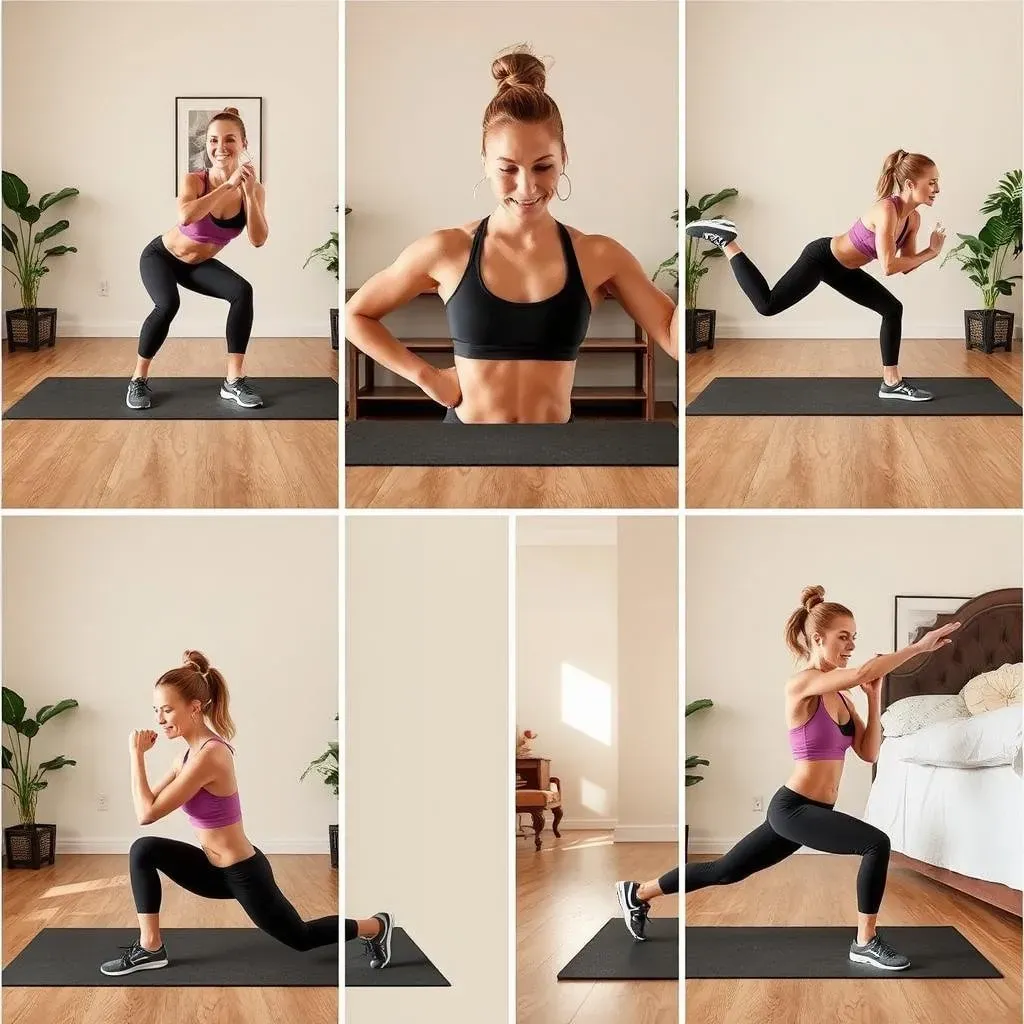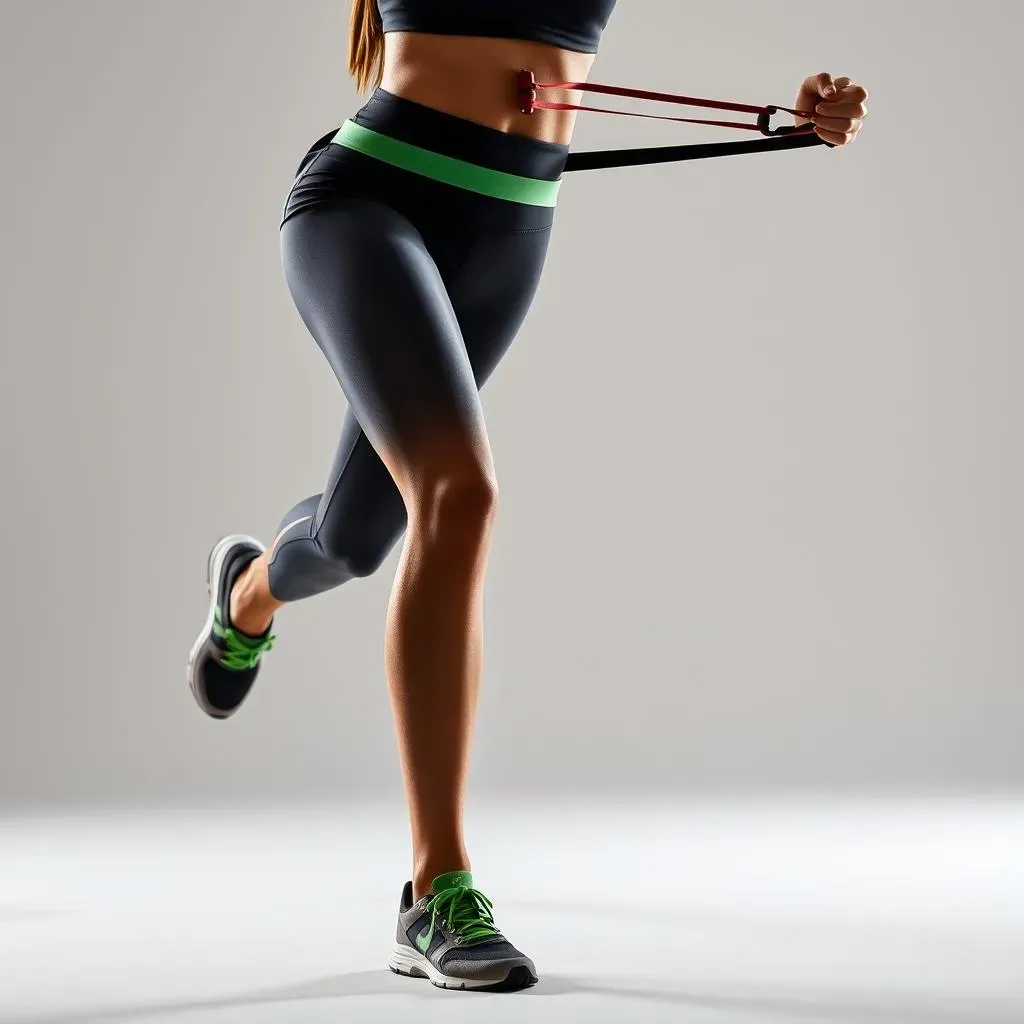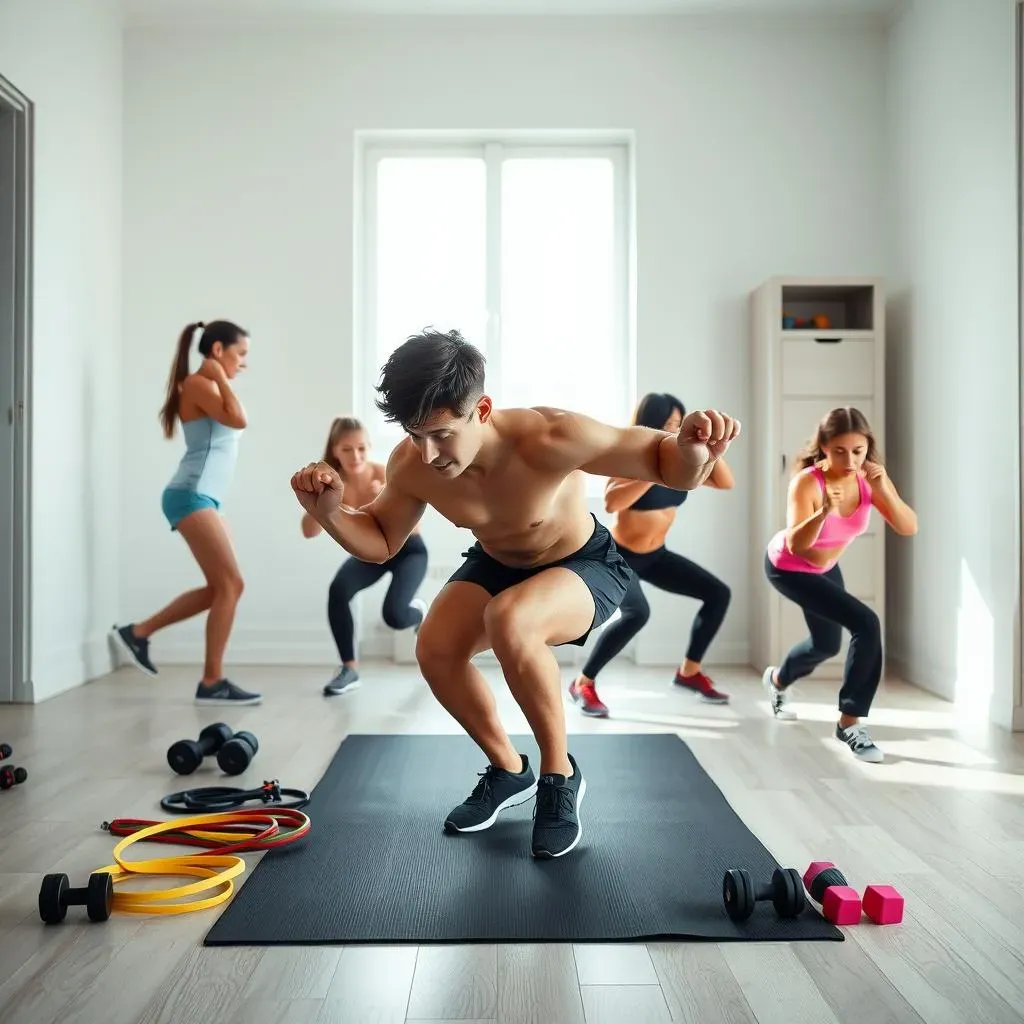Table of Contents
Ready to sculpt those legs without stepping foot in a gym? Then get ready to experience the power of a "HIIT workout at home for legs"! This article is your ultimate guide to transforming your lower body with high-intensity interval training, all from the comfort of your living room. We'll take you from beginner to advanced, providing tailored workouts to match your fitness level. Forget expensive gym memberships and complicated equipment – we'll show you how to build strength, endurance, and serious definition using only your bodyweight (or a few simple additions if you're feeling adventurous). We'll cover everything you need to know, from warming up properly to prevent injuries, to mastering the techniques of effective HIIT exercises, and finally, how to recover effectively to see optimal results. Get ready to unleash your inner athlete and discover the incredible results you can achieve with a dedicated HIIT workout at home for legs. Let's get started!
HIIT Workout at Home for Legs: A Beginner's Guide

HIIT Workout at Home for Legs: A Beginner's Guide
Getting Started: Your First HIIT Leg Workout
Hey there, newbie! Let's ditch the excuses and get those legs working. A beginner HIIT leg workout doesn't need fancy equipment; your bodyweight is your best friend. We'll focus on building a solid foundation of strength and endurance. Think of it like this: you're building a house, and a strong foundation is key. We'll start with simple exercises like squats, lunges, and calf raises. Remember, proper form is crucial to avoid injuries, so take your time and focus on quality over quantity. Don't worry about how many reps you do; instead, concentrate on doing each movement correctly. You can find a great beginner-friendly routine in our beginner HIIT workout guide.
Start with shorter workout sessions, maybe 10-15 minutes, a couple of times a week. Listen to your body and take rest days when you need them. This isn’t a race; it's a journey to a stronger, healthier you. Consistency is key! Remember, even a short, effective workout is better than no workout at all. And don't forget to warm up before you start! A quick 5-minute warm-up with some light cardio and dynamic stretches will prep your muscles for the workout ahead.
Exercise | Sets | Reps | Rest |
|---|---|---|---|
Squats | 3 | 10-12 | 30 seconds |
Lunges (each leg) | 3 | 10-12 | 30 seconds |
Calf Raises | 3 | 15-20 | 30 seconds |
Increasing Intensity: Gradually Progressing Your Workouts
Once you feel comfortable with the beginner routine, it's time to level up! We'll gradually increase the intensity and duration of your workouts. This could mean adding more reps, sets, or exercises. You could also try decreasing your rest periods between sets. Remember, the key to HIIT is short bursts of intense activity followed by brief recovery periods. This helps to improve both your cardiovascular fitness and your muscular strength. This is where you can really start to see those legs shaping up. Don’t forget to check out our dedicated leg HIIT routine for more ideas.
Consider incorporating variations of the exercises you've already mastered. For example, instead of regular squats, try jump squats or side squats. For lunges, you can add a twist or try reverse lunges. These variations will challenge your muscles in new ways and prevent plateaus. Remember, progression should be gradual and listen to your body. Don't push yourself too hard, especially at the beginning. Overtraining can lead to injuries and burnout. It's better to progress slowly and steadily than to rush things and get injured. Remember that consistency and proper form are more important than speed.
- Increase reps by 2-3 per set each week
- Add one set per exercise every other week
- Reduce rest time by 5-10 seconds each week
Listen to Your Body: Rest and Recovery
This is crucial, folks! Rest and recovery are just as important as the workout itself. Your muscles need time to repair and rebuild after a tough HIIT session. Aim for at least one or two rest days per week. During these rest days, you can still do some light activity like walking or stretching, but avoid intense workouts. This allows your body to recover properly and prevents overtraining. Adequate sleep is also essential for muscle recovery and overall health. Aim for 7-9 hours of quality sleep each night.
Nutrition also plays a significant role in recovery. Make sure you're eating a balanced diet that's rich in protein, carbohydrates, and healthy fats. Protein helps repair and rebuild muscle tissue, while carbohydrates provide energy for your workouts. Healthy fats support hormone production and overall health. Stay hydrated by drinking plenty of water throughout the day. Consider adding a quick 15-minute HIIT workout a couple of times a week to maintain your fitness level during rest days.
Intermediate HIIT Leg Workouts at Home: Level Up Your Training

Intermediate HIIT Leg Workouts at Home: Level Up Your Training
Adding Resistance: Amplify Your Leg Day
Alright, champ, you've conquered the basics! Now let's crank up the intensity. It's time to introduce resistance to your HIIT leg workouts. This doesn't necessarily mean hitting the gym; we can use readily available tools at home. Resistance bands are your new best friends; they're cheap, portable, and offer a fantastic way to increase the challenge of classic exercises like squats, lunges, and calf raises. Think of them as secret weapons for sculpting those legs. You'll find a great selection of exercises in our resistance band HIIT guide.
Don't have resistance bands? No worries! You can easily add resistance using household items. A filled water bottle or a sturdy bag of rice can be used for weighted squats and lunges. Get creative; the possibilities are endless! Remember that even small additions of weight can make a huge difference in the intensity of your workout. Start slowly and gradually increase the weight as you get stronger. Remember, focus on maintaining good form even as you increase the resistance.
Exercise | Resistance | Sets | Reps | Rest |
|---|---|---|---|---|
Resistance Band Squats | Light-Medium Band | 3 | 12-15 | 30 seconds |
Weighted Lunges (each leg) | 2-5 lb weights | 3 | 10-12 | 30 seconds |
Calf Raises (weighted) | 2-5 lb weights | 3 | 15-20 | 30 seconds |
Workout Duration and Intensity: Stepping It Up
Now that you’re comfortable with resistance, it’s time to play with workout duration and intensity. You can start by increasing the duration of your HIIT sessions. Try adding another 5-10 minutes to your usual workout. Or, you could increase the intensity by reducing the rest time between exercises. Remember, the magic of HIIT lies in those short bursts of intense work followed by brief recovery. This is where you'll start seeing real changes in your leg strength and definition. For more intense routines, explore our HIIT workouts for quick results.
Consider adding plyometric exercises to your routine. Plyometrics are explosive movements that involve jumping and hopping, such as jump squats and jump lunges. These exercises are great for building power and increasing your metabolism. Remember, always prioritize proper form to avoid injuries. If you're unsure about proper form, check out online resources or consult with a fitness professional. Don't forget to listen to your body; if you feel any pain, stop the exercise immediately.
- Increase workout duration by 5 minutes every other week
- Reduce rest periods by 10 seconds per week
- Incorporate 1-2 plyometric exercises per workout
Advanced Techniques: Mastering the HIIT Flow
You're getting serious now! Let's talk about mastering the flow of your HIIT workout. This isn't just about doing the exercises; it's about the rhythm and intensity. Focus on maintaining a consistent pace throughout your workout. Don't rush, but don't dawdle either. Find a rhythm that allows you to push yourself without compromising form. This takes practice, but the results are well worth it. For additional inspiration, check out our dedicated leg HIIT routine for more challenging moves.
Consider incorporating circuit training into your HIIT workouts. Circuit training involves performing a series of exercises one after the other with minimal rest. This keeps your heart rate elevated and maximizes calorie burn. You can customize your circuits to target specific muscle groups or to focus on overall fitness. Remember to gradually increase the difficulty of your circuits as you get fitter. Don't be afraid to experiment and find what works best for you.
Advanced HIIT Workout at Home for Legs: Push Your Limits

Advanced HIIT Workout at Home for Legs: Push Your Limits
Pushing Past Your Limits: Advanced HIIT Leg Workouts
Welcome to the advanced league! You've built a solid foundation, now it's time to really push those limits. We're talking intense, challenging workouts that will sculpt your legs like never before. Think explosive movements, shorter rest periods, and a serious commitment to pushing your physical boundaries. We'll be building on the techniques you've already mastered, adding complexity and increasing the overall intensity. Ready to take your leg day to the next level? Check out our advanced HIIT workout guide for some seriously challenging routines.
This phase is all about maximizing your results. We'll be incorporating more advanced variations of exercises you already know, along with introducing new, challenging moves. Think single-leg variations of squats and lunges, plyometric exercises like box jumps and jump squats, and advanced core work that will stabilize your body during these intense movements. Remember to focus on maintaining proper form, even as you increase the intensity. Small tweaks in form can make a huge difference in your results and reduce your risk of injury.
- Incorporate single-leg exercises (e.g., pistol squats, single-leg deadlifts)
- Add plyometric exercises (e.g., box jumps, jump lunges)
- Increase workout duration to 20-30 minutes
Supercharging Your HIIT: Advanced Techniques and Strategies
Now, we're not just building strength and endurance, we're building power and explosiveness. This is where you'll see a dramatic difference in your leg strength and definition. We'll be focusing on advanced techniques to optimize your HIIT workouts. This includes things like tempo training (controlling the speed of each repetition), drop sets (reducing the weight or resistance midway through a set), and supersets (performing two exercises back-to-back with minimal rest). These techniques will push your muscles to their absolute limits, forcing them to adapt and grow stronger.
Remember, proper nutrition and recovery are crucial for making progress at this level. You'll need to fuel your body properly to support these intense workouts. Consider increasing your protein intake to support muscle repair and growth. Prioritize sleep and take rest days when needed. Overtraining can lead to injuries and setbacks, so listen to your body and don’t be afraid to take a break. For more tips on optimizing your recovery, check out our guide to HIIT for quick results which includes recovery strategies.
Exercise | Sets | Reps | Rest |
|---|---|---|---|
Plyometric Jump Squats | 4 | 8-12 | 20 seconds |
Single-Leg Romanian Deadlifts (each leg) | 3 | 10-12 | 20 seconds |
Burpees | 4 | As many as possible (AMRAP) | 30 seconds |
HIIT Workout at Home for Legs: Safety, Recovery, and Results

HIIT Workout at Home for Legs: Safety, Recovery, and Results
Safety First: Preventing Injuries During Your HIIT Leg Workouts
Let's talk safety! HIIT workouts are intense, but that doesn't mean they have to be dangerous. Proper form is your number one defense against injuries. Before you start any exercise, take the time to learn the correct technique. There are tons of great videos online showing proper form for all the exercises we've covered. Don't rush into advanced moves before you're ready. Start with the basics and gradually increase the intensity as you get stronger. Listen to your body; if you feel any pain, stop immediately and rest.
Warm-up before each workout is essential. A 5-10 minute warm-up, including light cardio and dynamic stretching, will prepare your muscles for the workout. This increases blood flow to the muscles and reduces the risk of injury. Similarly, a cool-down after your workout is important for bringing your heart rate down gradually. Static stretching, holding each stretch for 30 seconds, is great for improving flexibility and recovery. Check out our beginner HIIT guide for warm-up and cool-down suggestions.
- Learn proper form for all exercises
- Warm-up before each workout
- Cool-down after each workout
- Listen to your body and rest when needed
Fueling Your Recovery: Nutrition and Hydration
Your body needs the right fuel to recover effectively after a tough HIIT leg workout. Focus on a balanced diet rich in protein, carbohydrates, and healthy fats. Protein is essential for muscle repair and growth, so make sure you're getting enough protein in your diet. Good sources include lean meats, fish, eggs, beans, and lentils. Carbohydrates provide energy for your workouts and help replenish glycogen stores in your muscles. Opt for complex carbohydrates like whole grains, fruits, and vegetables.
Healthy fats are also crucial for hormone production and overall health. Good sources include avocados, nuts, seeds, and olive oil. Don't forget about hydration! Water is essential for transporting nutrients to your muscles and flushing out waste products. Aim to drink plenty of water throughout the day, especially before, during, and after your workouts. You can find some great nutrition tips in our guide to HIIT for quick results.
Nutrient | Sources | Benefits |
|---|---|---|
Protein | Lean meats, fish, eggs, beans | Muscle repair and growth |
Carbohydrates | Whole grains, fruits, vegetables | Energy for workouts |
Healthy Fats | Avocados, nuts, seeds, olive oil | Hormone production, overall health |
Rest and Recovery: The Unsung Heroes of HIIT
Rest and recovery aren't just optional; they're crucial for seeing results from your HIIT leg workouts. Your muscles need time to repair and rebuild after intense exercise. Aim for at least one or two rest days per week. During these rest days, you can still engage in light activities like walking or stretching, but avoid intense workouts. This gives your body a chance to recover and prevents overtraining. Adequate sleep is also essential for muscle recovery and overall well-being. Aim for 7-9 hours of quality sleep per night. Prioritize sleep; it's when your body does most of its repair work.
Consider incorporating active recovery into your rest days. This involves light activities like yoga, swimming, or cycling. These activities promote blood flow and help flush out lactic acid, reducing muscle soreness. Remember, rest and recovery are just as important as the workouts themselves. They're the unsung heroes of your fitness journey. Don't neglect them! For more ideas on how to incorporate rest and recovery into your routine, check out our HIIT guide for busy people which includes rest and recovery tips.
